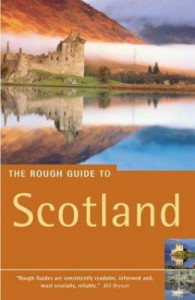 Rebecca Swain wrote this review.
Rebecca Swain wrote this review.
Yes, The Rough Guide to Scotland is great; buy it if you’re planning to go to Scotland. It has maps, information about each part of the country, phone numbers, history, everything you could possibly want in a travel guide.
What it doesn’t tell you is the individual, memorable little moments you will have when you get to Scotland.
You’ll read about Arthur’s Seat, the grassy, rocky volcano brooding over Edinburgh, from the top of which you can get a spectacular view across the city. Imagine your surprise, however, when, after climbing up, you dispense with walking altogether and slide most of the way back down the slope on your butt, to the amazed and gleeful laughter of young children.
It tells you why the Kingdom of Fife is still designated a kingdom, and what historic sites you can see there: the Cathedral, St. Andrews, the oldest golf course in the world, etc. But you won’t hear the solemn voice of the bus driver/tour guide telling you so many lurid tales of witch-burnings and ludicrous royal deaths that at last you find yourself laughing helplessly, wondering if anyone on Fife ever died in their bed. You’ll read about the tiny fishing villages, but you won’t realize what it’s like riding on streets so narrow you don’t think the bus will make it around the next corner without getting stuck between the buildings.
The Rough Guide tells you about the Highlands: Inverness, Loch Ness, Ben Nevis. But it doesn’t tell you how you will feel in a boat on Loch Ness, staring down into the gray water, wondering if your eyes will meet those of a monster. Or climbing partway up Ben Nevis with the wind blowing so hard it keeps knocking you backward. You won’t know that you can take a bus tour with a crazy guy named Fred who careens the bus back and forth across the road so passengers on both sides can see everything, who races trains, and forgets what he’s saying halfway through his sentences until prompted by a shout from someone at the back of the bus: “Ian Fleming!”
You will find out that Skye means “cloud,” but the day you arrive on that particular Small Isle the sky will be so blue, the sun so bright, you will think that you’ve never seen anything as lovely as the hills reflected in the lochs. You really need a car to get around on Skye, The Rough Guide tells you, though the island is great for climbers. But try to figure out what to do with no car, when the easiest climbing path near Portree is washed out. You end up wandering around the town, watching the sunset from the top of a hill near someone’s yard until a tiny old woman opens her back door and looks suspiciously out at you. You wave and smile and say brightly, “We’re just watching the sunset. We’re visitors. Your island is so beautiful”; then you realize that she might speak Gaelic (Skye is a Gaelic cultural center, even the street signs are in Gaelic) and might not understand a word you’re saying. And for a slashing moment that old feeling of not belonging anywhere comes over you.
You don’t know that you’ll have a chance to take a boat to a tiny island called Rona, instead of the usual tourist trip around Skye. Only two people live there, the caretaking couple. You go because there is a sick calf, and the captain of your boat used to be a veterinarian, so the Portree vet asks him if he could take a look … so you take a look, too. Along with four young men from Glasgow, surrounded by their camping gear and a dog the size of a Shetland pony, who are planning to stay on Rona for a week.
You read the section on traveling with disabilities and get valuable phone numbers, and the information that Scotland is not a very wheelchair accessible place. But you can’t imagine how many hills and steps there are in Edinburgh alone; that you’ll lose six pounds just walking around, and even though the ferry from Mallaig has an accessible restroom, what on earth will the wheelchair user do when he gets to Skye?
You’ll cry at the Scottish war memorial in the chapel of Edinburgh Castle, and give in to an inexplicable compulsion to stand in the great oven in the Earl of Argyll’s house. And you’ll be delighted when the bus from Portree back to the Skye ferry (the equivalent of Greyhound) turns out to be a combination schoolbus/mail delivery bus, dropping off newspapers and schoolchildren in tiny towns along the way.
My point is, The Rough Guide to Scotland is an excellent travel book. It gives you all the information you need to plan a wonderful trip, and interesting cultural and historical information besides. But it’s up to you to fill in the spaces between the words with your own experiences.
You can also purchase The Rough Guide to the Scottish Highlands and Islands, and The Rough Guide to Edinburgh.
(Penguin, 2000)
